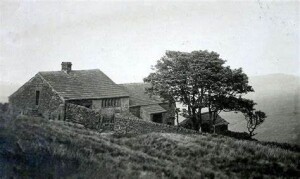 The journalist George Hutchinson (see previous Jots) was living in wartime Bradford when he visited High Withens, the supposed ‘ dwelling ‘ of Mr Heathcliffe of Emily Bronte’s Wuthering Heights. Up on the lonely moors Hutchinson finds it hard to recognise that ‘England is at war’,
The journalist George Hutchinson (see previous Jots) was living in wartime Bradford when he visited High Withens, the supposed ‘ dwelling ‘ of Mr Heathcliffe of Emily Bronte’s Wuthering Heights. Up on the lonely moors Hutchinson finds it hard to recognise that ‘England is at war’,
‘ Indeed, though the only indication in the whole locality is the scores of little evacuees and mothers, mostly from Bradford. The moor air and country rambles they have exchanged for city life should be of lasting benefit to these children and to many a mother, I am told, the rural beauty so near to Bradford has been quite a revelation—which in itself is salutary.’
Doubtless, in these days of local lockdowns, such salubrious open-air refuges from unhealthy urban landscapes, are appreciated for different reasons.
Hutchinson had already visited the Bronte Waterfall, not far from the Haworth Parsonage and this was not his first visit to Stanbury, the nearest village to High (or top) Withens, which he had never managed to reach before. On the way there he popped in to see the famous Jonas Bradley, former Head of Stanbury School and an international Bronte expert, at his home, Horton Croft in the village. Here he was invited to sign, not for the first time:
‘the third of the visitors’ books that Mr Bradley has kept since 1904. These books contain thousands of signatures, and his callers, they will tell you, have come from places as far apart as Glasgow and Godalming, Bulawayo and Brooklyn…’
This was probably the last time that Hutchinson saw Bradley, for he died early in 1943, aged 84, his obituary appearing that year in volume 10 of the Transactions of the Bronte Society, which he had helped to found many decades before. In this obituary Bradley’s reputation worldwide as a Bronte expert was confirmed. He had indeed been visited by ‘American University professors, statesmen, film directors and writers..’
Leaving Horton Croft Hutchinson took the left hand turning towards High Withins:
‘the road, now a mere cart track, skirts a small isolation hospital and narrows into a footpath…The moorland sheep, nibbling, made off as I approached the ruins of a farmhouse whose walls, rising a few feet above the piled stone around them, are separated from their neighbour, High Withens, by, perhaps a hundred yards…’
Hutchinson rightly declares that though High Withens is the ‘ accepted prototype of Wuthering Heights ‘, the building described by Bronte was ‘ probably six times as big as the small farmhouse that stood before him, ‘ empty, doorless, its windows bereft of glass.’ Its walls, we are also told, were scarred with names and initials. ‘ Dublin is represented; so, nearer home, is Dudley Hill.’ Satisfied with what he has seen, Hutchinson starts off back to the civilisation of Stanbury, avoiding the risk of ‘ the atmospheric tumult ‘ to which Bronte said ‘ this station is exposed in stormy weather.’
R.M.Healey.
